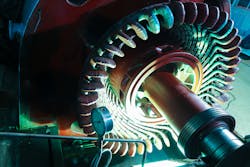Case Study: Pinpointing industrial energy-saving opportunities
By Adrian Guggisberg, president of motion services at ABB Motion
Industrial electric motors are a major opportunity for energy savings. According to the International Energy Agency (IEA), around 70% of all electricity consumed by industry is used by millions of motors that power machines, pumps, conveyors and other applications. Many of these operate inefficiently, drawing more power than they really need.
However, when we surveyed industrial leaders this year, we found that relatively few businesses are actively pursuing this opportunity. Although 90% of respondents saw energy prices as a threat to the profitability, only 51% were planning to use an energy appraisal to identify poorly performing motors.
It’s likely that the high cost and low coverage of traditional energy appraisals are a barrier. Because these are labor-intensive, they typically focus on just the biggest and most powerful motors, which are perceived as offering the biggest potential for savings. However, many operators have realised that major energy savings can also be found by combining efficiency improvements from many smaller motors.
Modern technology has lowered the barrier to gathering data from a fleet of motors and evaluating their efficiency. It is now inexpensive and straightforward to gather digital data to see which electric motors are using more energy than they should. Expert analysis can also show how to boost efficiency with a known return on investment.
In turn, operations managers can make informed decisions to reduce energy consumption for the lowest-efficiency motors. Solutions to boost efficiency include altering operational schedules, installing a variable-speed drive (VSD) and upgrading to high-efficiency technology.
Generally, operators will take action when the return on investment is two years or less. Therefore, today’s high energy prices are making it viable to upgrade many more motors than in the past and operators can achieve big energy savings from the sum of many small improvements.
CERN taking action
The approach is being adopted by particle-physics laboratory CERN in Switzerland. The facility wants to cut energy consumption from its cooling system, which is critical to the success of its experimental program. Motors use around 20% of the facility’s total energy consumption in a network of pumps, fans, compressors and cooling towers, equivalent to 260 gigawatt-hours (GWh) every year.
CERN is now working with ABB with the goal of cutting this energy consumption by 15% and is harvesting data from connected motors to identify where most energy can be saved.
Data from the same sources is also providing the laboratory technical team with insight into the condition of equipment. Constant monitoring identifies changes in operational parameters such as temperature and vibration that show when components in motors and other equipment are approaching the end of their life. As a result, operators can replace systems before they fail and avoid unplanned outages, which protects the continuity and success of the experiments. An unplanned outage lasting 30 minutes could stop an experiment for 48 hours.
“Our innovation partnerships help us to enable positive societal impact from our work pushing the limits of science and engineering at CERN,” said Han Dols, head of business development and entrepreneurship from CERN. “We have partnered with ABB to generate insights to help reduce our own electricity footprint, as we continue to test the extremes at such a large facility. We also hope to inspire other big science facilities and industry to do the same and, as such, have agreed with ABB to share the learnings of this project publicly.”
Electricity as a precious resource
The data-driven approach to energy efficiency has a lot of merit today due to the energy crisis. However, demand for electricity is likely to double over the coming 15-20 years as businesses switch from fossil-fuel plant to electrical motion to meet net-zero targets.
This trend for electrification will create more incentive for industrial operators to invest in better energy efficiency. It will help them control electricity demand in the short term, keeping bills and CO2 emissions under control. However, it will also free up energy resources for other consumers over the long run.
Over time, it’s likely that the data-driven approach to energy appraisals and condition monitoring will evolve into a new business model. This will see partners taking on operational risk and using data and expertise to deliver specific outcomes such as minimizing energy consumption or maximizing process continuity.
